实验六 进程基础
| 项目 | 内容 |
|---|---|
| 这个作业属于哪个课程 | [2020春季Linux系统与应用] |
| 这个作业的要求在哪里 | <实验六作业要求> |
| 学号-姓名 | 17041503-李美霞 |
| 作业学习目标 | 1.掌握Linux系统环境C语言编程概念 2.学习Linux系统进程概念 |
-
请举例说明静态链接库的创建与使用。
ar:建立,修改档案或从档案中抽取成员
ar -r :替换归档文件中已有的文件或加入新文件
ar -t :显示归档文件内容

举例:
//文件名:add.c,加法 int add(int a,int b){ return a+b; }//文件名:sub.c,减法 int sub(int a,int b){ return a-b; }//文件名:main.c #include <stdio.h> int add(int a,int b); int sub(int a,int b); int main(){ printf("3 + 1 = %d\n",add(3,1)); printf("3 - 1 = %d\n",sub(3,1)); return 0; }
-
请举例说明共享库的创建与使用。
开始的目录结构:

//文件名:common.h #ifndef _COMMON_ #define _COMMON_ int add(int a,int b); int sub(int a,int b); #endif//文件名:add.c int add(int a,int b){ return a+b; }//文件名:sub.c int sub(int a,int b){ return a-b; }//文件名:main.c #include<stido.h> #include"common.h" int main(){ printf("3+1=%d\n",add(3,1)); printf("3-1=%d\n",sub(3,1)); }创建共享库:
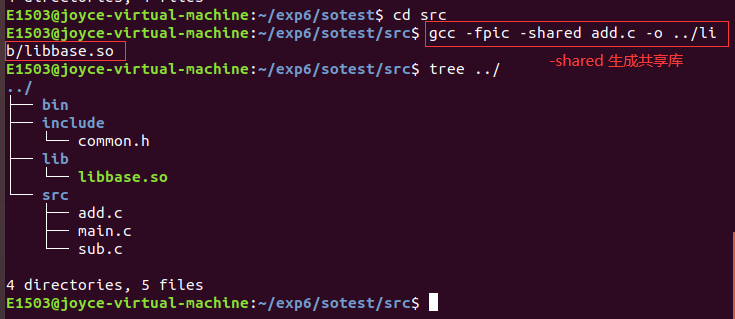
使用自己的共享库:方式一:
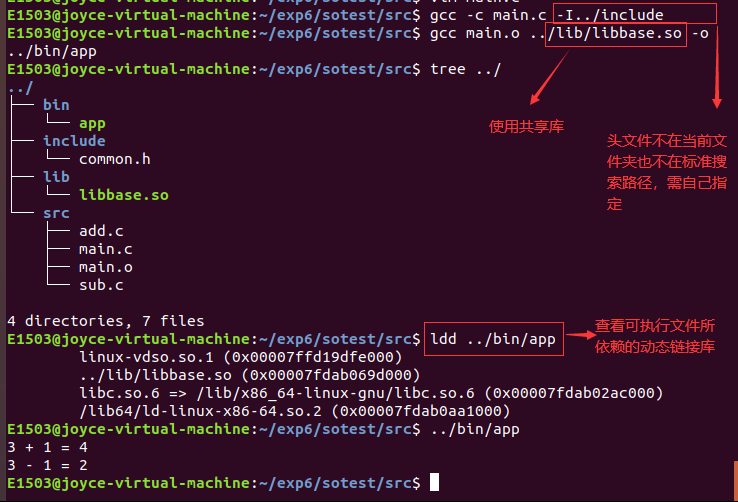
方式二:
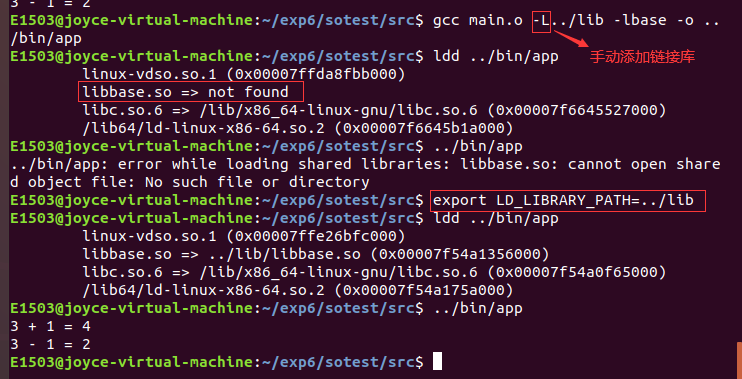
-
编程实现一个简单文件复制命令。
//文件名:mycp.c #include <unistd.h> #include <sys/types.h> #include <sys/stat.h> #include <fcntl.h> #include <stdio.h> #define BUFFERSIZE 4096 int main(int argc, char* argv[]) { if (argc != 3) { printf("usage:\n mycp src dst\n"); return 1; } int srcfd = open(argv[1], O_RDONLY); if (srcfd == -1) { perror("open"); return 1; } int dstfd = open(argv[2], O_CREAT | O_WRONLY, 0666); if (dstfd == -1) { close(srcfd); perror("open"); return 1; } int len = 0; char buffer[BUFFERSIZE] = {0}; while((len = read(srcfd, buffer, BUFFERSIZE)) > 0) { if (write(dstfd, buffer, len) != len) { perror("write error"); return 1; } } if (len < 0) { perror("read error"); return 1; } close(srcfd); // 关闭文件 close(dstfd); return 0; }
mycp.c文件复制前:
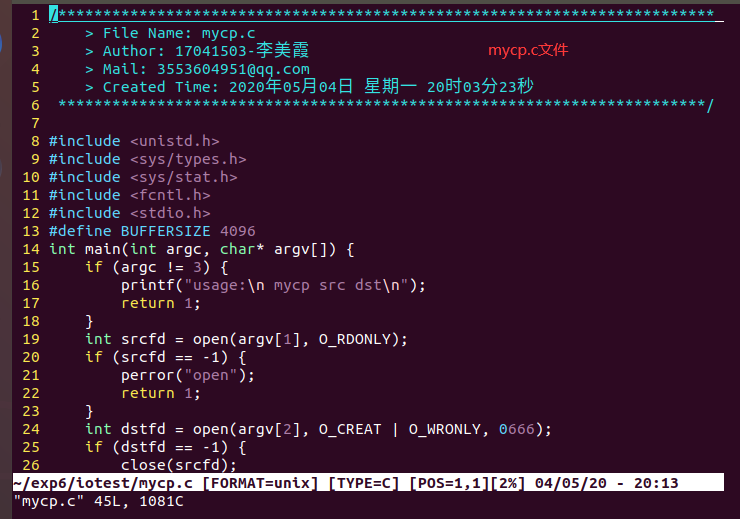
复制后(test文件):

-
使用
fork创建一个子进程,进程创建成功后父子进程分别输出不同的内容。fork:创建一个子进程

///文件名:fork1.c #include <stdio.h> #include <stdlib.h> #include <unistd.h> int main(){ pid_t pid; printf("[%d]:Begin! \n",getpid()); fflush(NULL); pid = fork(); if(pid<0) { perror("fork()"); exit(1); } else if(pid > 0) { printf("[%d]:Parent process if working!\n",getpid()); } else { printf("[%d]:Child process if working!\n",getpid()); } printf("[%d]:Finish!\n",getpid()); return 0; }
全缓冲: 全缓冲指的是系统在填满标准IO缓冲区之后才进行实际的IO操作; 注意,对于驻留在磁盘上的文件来说通常是由标准IO库实施全缓冲。 行缓冲: 在这种情况下,标准IO在输入和输出中遇到换行符时执行IO操作; 注意,当流涉及终端的时候,通常使用的是行缓冲。(1)删除fork1.c文件中 fflush(NULL); 这一行后运行结果为:

(2)继续删除fork1.c文件中 “ printf("[%d]:Begin! \n",getpid()); ” 这一句中的“\n”结果为:
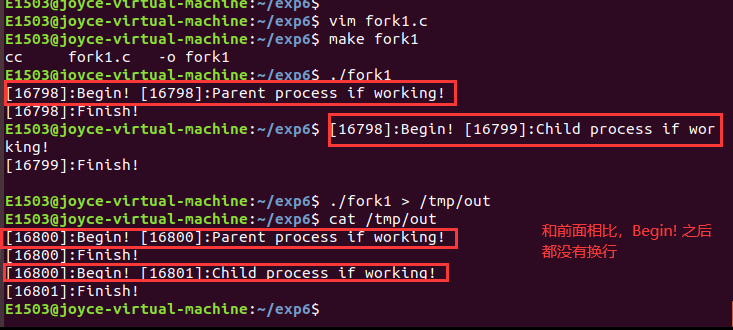
-
使用fork创建多个子进程。
这里请大家分析假如有下列代码段:
int i; pid_t pid; for (i = 0; i < 3; i++) pid = fork();上面代码段会产生多少子进程?
会产生: 2^3-1=7个子进程。//文件fork2.c #include <stdio.h> #include <stdlib.h> #include <unistd.h> int main(){ int i; pid_t pid; printf("[%d] Begin! \n",getpid()); for (i = 0;i < 3; i++) { if((pid = fork()) ==0 ) break; } if(pid<0) { perror("fork()"); exit(1); } else if(pid > 0) { printf("[%d] Parent process is working!\n",getpid()); } else { printf("[%d] Child process %d is working!\n",getpid(),i); } return 0; }
用sleep函数来控制进程输出顺序:

#include <stdio.h> #include <stdlib.h> #include <unistd.h> int main(){ int i; pid_t pid; printf("[%d] Begin! \n",getpid()); for (i = 0;i < 3; i++) { if((pid = fork()) ==0 ) break; } if(pid<0) { perror("fork()"); exit(1); } else if(pid > 0) { sleep(3); printf("[%d] Parent process is working!\n",getpid()); } else { sleep(i); printf("[%d] Child process %d is working!\n",getpid(),i); } return 0; }
-
在 fork 之前以写的方式创建了一个文件 test.txt。然后 fork 出的子进程立即向文件中写入“world”,然后睡眠5秒。而父进程在 fork 后睡眠3秒后向 test.txt 写入 "hello",并关闭描述符。子进程恢复后,又向 test.txt 文件中写入 "lalala"后关闭描述符,结束。
//文件forkwrite.c #include <unistd.h> #include <sys/types.h> #include <sys/stat.h> #include <fcntl.h> #include <stdio.h> int main() { int fd = open("test.txt",O_WRONLY | O_CREAT,0664); if (fd == -1){ perror("open"); return 1; } printf("I'm father\n"); printf("before fork\n"); pid_t pid = fork(); if (pid > 0){ sleep(3); printf("I'm father; I'm writing test.txt...\n"); write(fd, "hello", 5); close(fd); } else if (pid ==0){ printf("I'm child; I'm writing test.txt...\n"); write(fd, "world", 5); sleep(5); write(fd, "lalala", 6); close(fd); } else { perror("fork"); return 1; } return 0; }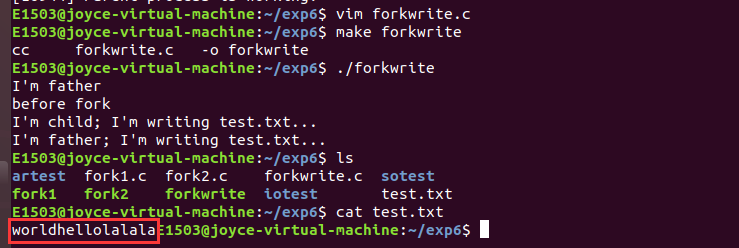
-
分别在主函数中使用
execvp启动ls命令以及使用fork函数产生子进程调用execvp启动ls。(1)使用execvp启动ls命令:
#include <stdio.h> #include <stdlib.h> #include <unistd.h> int main(){ char* argv[] = {"ls","-l",NULL}; if (execvp("ls",argv) == -1){ perror("exec"); return 1; } return 0; }
(2)使用fork函数产生子进程调用execvp启动ls命令:
#include <stdio.h> #include <stdlib.h> #include <unistd.h> int main(){ char* argv[] = {"ls","-l",NULL}; pid_t pid = fork(); if (pid > 0){ printf("I'm father\n"); } else if (pid == 0) { printf("I'm child\n"); if (execvp("ls",argv) == -1){ perror ("exec"); return 1; } } else { perror("fork"); return 1; } return 0; }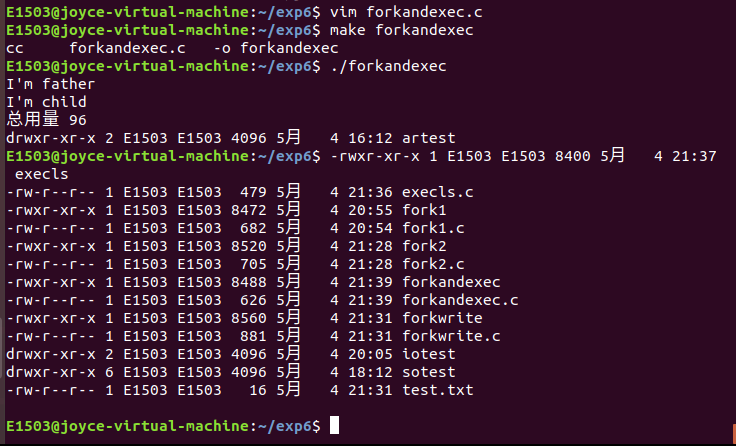
-
创建5个僵尸进程,并在终端通过
ps axf命令查看僵尸进程信息。#include <unistd.h> #include <stdio.h> #include <string.h> int main() { printf("before fork\n"); pid_t pid, n = 5; while(n--) { pid = fork(); if (pid == 0) break; else if (pid < 0){ perror("fork"); return 1; } } if (pid == 0) { printf("hello, I'm child %d; my father is %d\n", getpid(),getppid()); //getpid() 获取当前进程的pid //getppid() 获取当前进程的父进程的pid return 0; } while(1) { sleep(3); printf("hello, I'm father %d\n", getpid()); } return 0; }
在终端中新建一个窗口,输入:
ps axf //显示进程见关联的树状结构图
-
通过
wait来清理僵尸进程。wait(等待子进程中断或结束) (1)表头文件: #include<sys/types.h> #include<sys/wait.h> (2)定义函数: pid_t wait (int * status); (3)函数说明: wait()会暂时停止目前进程的执行,直到有信号来到或子进程结束。如果在调用wait()时子进程已经结束,则wait()会立即返回子进程结束状态值。子进程的结束状态值会由参数status 返回,而子进程的进程识别码也会一快返回。如果不在意结束状态值,则参数status可以设成NULL。 (4)返回值: 如果执行成功则返回子进程识别码(PID),如果有错误发生则返回-1,失败原因存于errno 中。#include <unistd.h> #include <stdio.h> #include <string.h> #include <sys/wait.h> #include <sys/types.h> int main() { printf("before fork\n"); pid_t pid, n = 5; while(n--) { pid = fork(); if (pid == 0) break; else if (pid < 0) { perror("fork"); return 1; } } if (pid == 0) { printf("hello, I'm child %d;my father is %d\n",getpid(),getppid()); return 0; } while(1) { sleep(3); pid = wait(NULL); if (pid == -1) { perror("wait"); sleep(10); printf("I'm father %d;I have wiped out all zombies\n",getpid()); return 1; } printf("Hello, I'm father %d; child %d exit\n",getpid(),pid); } return 0; }
-
父进程通过
waitpid函数等待特定子进程结束,若该子进程不结束,父进程一直阻塞。waitpid (1)函数功能:用来等待某个特定进程的结束 (2)函数原型: pid_t waitpid(pid_t pid, int *status, int options); (3)参数: status如果不为空,会把状态信息写到它指向的位置 options允许改变waitpid的行为,最有用的一个选项是WNOHANG,它的作用是防止waitpid把调用者的执行挂起. (4)返回值:成功返回等待子进程的pid,失败返回-1#include <stdio.h> #include <signal.h> #include <unistd.h> #include <errno.h> #include <sys/types.h> #include <sys/wait.h> #include <stdlib.h> void handler(int sig) { pid_t pid; while ((pid = waitpid(-1,NULL,WNOHANG)) > 0) { printf("wait child sucess : %d\n",pid); } } int main() { signal(SIGCHLD,handler); pid_t pid = fork(); if (pid == 0) { printf("child1 pid : %d\n",getpid()); sleep(3); exit(1); } pid_t pid2 = fork(); if (pid2 == 0) { printf("child2 pid2 : %d\n",getpid()); sleep(5); exit(2); } pid_t pid3 = fork(); if (pid3 == 0) { printf("child3 pid3 : %d\n",getpid()); sleep(7); exit(3); } printf("father pid : %d\n",getpid()); while (1) { printf("father do self\n"); sleep(1); } return 0; }





